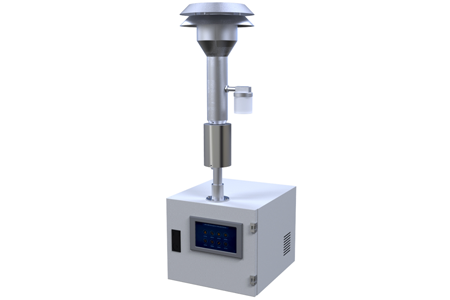DPM-6000 PM Monitor PM2.5/PM10
(2020年11月13日)Overview
Inhalable particle content is one of the most important indexes for measuring air quality. Combining years of experience in developing environment and safety monitoring instruments as well as the latest demand at home and abroad, our company has launched a new generation DPM-6000 atmospheric particulate monitor with high accuracy, reliability, stability and economy. It can measure PM10, PM2.5 and dust particles of other cut sizes, widely applied in inhalable particles concentration detection in environmental atmosphere monitoring.
Principle Of DPM-6000 PM Monitor PM2.5/PM10
The monitoring principle of the analyzer is mainly based on enrichment technology of atmospheric particulate and beta ray attenuation method. The instrument concentrates on particulate matters whose aerodynamic equivalent diameter is smaller than 2.5/10μm on the rolled filter membrane. The instrument adopts low-radiation 14C as a radioactive source. The emitted Beta-ray passes through the filter membrane with contaminants and will be received by the detector. The detector is composed of a photo-multiplier tube (or Geiger detector), plastic scintillator and counter. The thickness of enrichment can be analyzed quantificationally according to Beta-ray energy that detector received, then the PM2.5/10 concentration in the air can be calculated.
Features Of DPM-6000 PM Monitor PM2.5/PM10
The design of the gas path keeps filter paper, a radioactive source and detector immovable during enrichment and measurement, ensuring a good lower detection limit.
US EPA standard beta ray attenuation method, which spares the complicated operations of TEOM, such as manually replace filter paper and weight. Compared to the light scattering method, it has higher measurement accuracy.
Cutter, based on simulation verification of aerodynamics, will provide a various selection of accurate particle.
Sizes: PM1, PM2.5, PM10, TSP.
Sampling flow is measured by a mass flow sensor and corrected with collected ambient temperature and pressure to get the sampling flow of the field.
Use C14 source which is of low-density, low activity, and long half-life to realize stable measurement. No special protection is needed. Reliable and safe.
Flexible paper-pressing structure. Mechanical driving design is simple and reliable; greatly reduce paper breaking and paper jam and avoid the error caused by the moving of filter paper.
The pipeline heating system is used to eliminate interference from ambient humidity and make the detector fit into sudden.
Flow control system with precise closed-loop feedback; stable sampling flow and small error.
Various external ports, such as RS232/RS485, 4~20mA and etc.
Low maintenance frequency, once a year.
Specification Of DPM-6000 PM Monitor PM2.5/PM10
Measuring principleBeta ray attenuation method
Performance IndexMeasuring Range0~1000μg/m3³or 0~10000μg/m3 (optional)
Radioactive Source14C (carbon-14), radioactivity≤60μCi
Accuracy≤5%
Display Resolution1μg/m3
Lower Detection Limit5μg/m3
Flow Error≤±2% (generally set at 16.67L/min)
Sampling Flow Stability≤±2% working point flow/24h
Sampling Period≤1h (time is settable)
Sampling FlowDefault 16.67L/min
ParallelismPM10≤10%, PM2.5≤15%
Filter Paper TapeFilter Paper TapeGlass fiber, inner diameter: 40 mm, width: 30 mm, service time 1 month (work period 1 h)
Interface Para.I/ORs232, RS485, 4-20mA, GPRS (optional)
Data StorageOne year
Working ConditionCutting headerAmbient temperature (-40~50)℃, ambient pressure (80~106kPa)
DetectorAmbient temperature (5-40)℃, ambient pressure (80-106kPa), humidity (≤90%)
Power SupplyAC (220±22)V, (50±1)Hz
Dimension & Weight483×407×322(mm) (L×W×H); Monitor 30kg, Pump 8kg
Application Of DPM-6000 PM Monitor PM2.5/PM10
Inhalable particle real-time monitoring in industry,, construction, residential district and etc.
Environment assessment, permission, and pollution forecast and pre-warning.
Ambient air quality monitoring and mobile air monitoring experimental station.
Occupational disease research, and long-term background environment research.
Secondary emission monitoring (coal storage area, wharf, etc.).
- このできごとのURL:



コメント